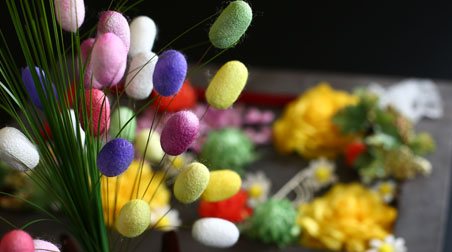The two traditional craft products distinctive to Murakami represent markedly contrasting facets of local history.
Murakami Kibori Tsuishu

Murakami carved lacquerware (kibori tsuishu) is noted for its intricate detailing and deep red hues. It is a reminder of the city’s history as a castle town where artisans worked under the patronage of the daimyo lord. During the Edo period (1603–1867), Murakami samurai learned wood carving techniques while stationed in Edo (present-day Tokyo), then brought that knowledge back to Murakami, an area noted for its production of natural urushi lacquer. The result was a community of specialized artisans who worked in turn to create decorative items such as plates, vases, and furniture for high-ranking samurai, priests, and wealthy merchants.
A woodturner would first shape a piece of highly durable bigleaf magnolia (honoki) or horse-chestnut (tochi) wood on a lathe and then pass it to a carver, who would shape it further and often engrave it with ornamental patterns. A lacquer artist would then apply several layers of urushi to the piece, then transform the natural luster of the lacquer into a matte finish with a mixture of charcoal, whetstone powder, and water applied with a horse-hair brush. The carver would then add additional detail to the engravings, and the item would be finished with a single layer of transparent urushi. This painstaking process, still practiced by today’s artisans, results in long-lasting products that regain the characteristic luster of urushi little by little as the matte surface wears out.
Although Murakami carved lacquerware has its origins in decorative items, local artisans now use the same techniques when making cups, chopsticks, soup bowls, and other items for daily use.
Experience Kibori Tsuishu
At Murakami Kibori Tsuishu Kaikan, they exhibit and sell their artwork made by craftsmen and their process and tools are exhibited.
Also, you carve chopsticks and teapot holder (It takes about an hour. Reservation require).

Uetsu Shinafu

Uetsu bast cloth (shinafu), on the other hand, emerged under circumstances far removed from the elegance of samurai society. Since prehistoric times, people in remote villages throughout the Uetsu region (what is now northern Niigata, Yamagata, and southern Akita Prefectures) have been making cloth out of the bast (inner bark fibers) of linden trees. The bast would be removed from the trees during the rainy season in June and early July. It would then be boiled in lye and soaked in rice bran to soften the fibers, then dried in the autumn air before being drawn out into thread and woven into fabric.
Bast cloth was traditionally used to make clothing and coarse bags in which people carried nuts and berries back from the forest. Nowadays, artisans are turning the material into a wide variety of stylish accessories, including pencil and business card cases, wallets, and hats.
Experience others

Dyed textile
This shop make thin towels, curtains, happy coats, and others from dyed material. You can dye textile using Murakami-cha (reservation required).

Silk flowers
Silk flowers are artwork made from dyed silk cocoon balls and processed into flowers. At Asahi Silk Flower Seisaku Kobo, you can try making your own.




